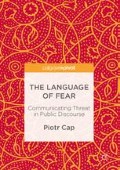Abstract
This chapter demonstrates that the original terrain of Proximization Theory, anti-terrorist discourse, has expanded to blend with other domains, such as discourse of cyberspace. Originally a mundane technological discourse, the discourse of cyberspace has changed dramatically after 9/11, incorporating fear-inducing alerts to the possibility of cyberattacks. The chapter shows that, today, the discourse of cyberspace has virtually turned into the discourse of cyberthreat, reflecting general context of uncertainty and common anxiety following the WTC and the Pentagon terrorist attacks. It includes a variety of proximization strategies which construe ‘clear and present’ threats in order to trigger public mobilization and response.
Access this chapter
Tax calculation will be finalised at checkout
Purchases are for personal use only
Notes
Bibliography
Adams, J. & F. Guterl. (2003, 3 November). Bringing down the Internet. Newsweek. http://msnbc.msn.com/id/3339638/.
Bendrath, R. (2003). The American cyber-angst and the real world: Any link? In R. Latham (Ed.), Bombs and bandwidth: The emerging relationship between information technology and security (pp. 34–51). New York: New Press.
Cohn, C. (1987). Sex and death in the rational world of defense intellectuals. Signs: Journal of Women in Culture and Society, 12, 13–26.
Collin, B. (2001). The future of cyberterrorism. Proceedings of 11th Annual International Symposium on Criminal Justice Issues, University of Illinois at Chicago.
Eriksson, J. (2001). Cyberplagues, IT, and security: threat politics in the information age. Journal of Contingencies and Crisis Management, 9, 210–222.
Gellman, B. (2012, 27 June). Cyber-attacks by Al Qaeda feared. Washington Post. http://www.washingtonpost.com/ac2/wp-dyn/A50765-2002Jun26.
Graham, S. (2004). War in the “weirdly pervious world”: infrastructure, demodernisation, and geopolitics. Paper presented at the conference on Urban Vulnerability and Network Failure, University of Salford.
Jarvis, L. (2016). Unpacking cyberterrorism discourse: Specificity, status and scale in news media constructions of threat. European Journal of International Security, 16, 20–35.
McGray, D. (2003). The minister of net defense. Wired 11. http://www.wired.com/wired/archive/11.05/schmidt.html.
Porteus, L. (2001, 15 May). Feds still need to define role in tackling cyberterror, panelists say. GovExec.com. http://www.govexec.com/dailyfed/0501/051501td.htm.
Sandwell, B. (2006). Monsters in cyberspace: cyberphobia and cultural panic in the information age. Information, Communication & Society, 9, 39–61.
Schwartau, W. (1994). Information warfare: Cyberterrorism - Protecting your personal security in the electronic age. New York: Thunder’s Mouth Press.
Specter, M. (2001, 28 May). The doomsday click: how easily could a hacker bring the world to a standstill? The New Yorker.
Vegh, S. (2012). Disrupting the status quo: non-traditional uses of the Internet as a political force, Ph.D. thesis, University of Maryland.
Verton, D. (2003). Black ice: The invisible threat of cyberterrorism. New York: McGraw Hill.
Wallace, C. (2002, 16 September). Internet as weapon: experts fear terrorists may attack through cyberspace. ABC News.com. http://abcnews.go.com/sections/wnt/DailyNews/cyberterror020913.html.
Yould, R. (2003). Beyond the American fortress: Understanding homeland security in the information age. In R. Latham (Ed.), Bombs and bandwidth: The emerging relationship between information technology and security (pp. 70–98). New York: New Press.
Author information
Authors and Affiliations
Copyright information
© 2017 The Author(s)
About this chapter
Cite this chapter
Cap, P. (2017). Technological Discourse: Threats in the Cyberspace. In: The Language of Fear. Palgrave Macmillan, London. https://doi.org/10.1057/978-1-137-59731-1_5
Download citation
DOI: https://doi.org/10.1057/978-1-137-59731-1_5
Published:
Publisher Name: Palgrave Macmillan, London
Print ISBN: 978-1-137-59729-8
Online ISBN: 978-1-137-59731-1
eBook Packages: Social SciencesSocial Sciences (R0)

